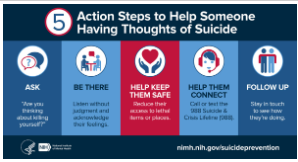Resources

Who is at risk of suicide?
People of all ages, sexes, and ethnicities can be at risk for suicide. The main risk factors for suicide are: A history of suicide attempts - Depression, other mental disorders, or substance use disorder - Chronic pain - Family history of a mental disorder or substance use Family history of suicide - Exposure to family violence, including physical or sexual abuse - Presence of guns or other firearms in the home - Having recently been released from prison or jail - Exposure, either directly or indirectly, to others’ suicidal behavior, such as that of family members, peers, or celebrities - Most people who have risk factors for suicide will not attempt suicide, and it is difficult to tell who will act on suicidal thoughts. Although risk factors for suicide are important to keep in mind, someone who is showing warning signs of suicide may be at higher risk for danger and need immediate attention. - National Institue of Mental Health
Learn More
Do you know the warning signs of suicide?
Here are behaviors or signs of someone thinking about suicide. Talking about wanting to die, great guilt or shame, or being a burden to others. Feeling empty, hopeless, trapped, or having no reason to live. They may be really sad, more anxious, agitated, or full of rage. They may be in unbearable emotional or physical pain. Changing behavior, such as: making a plan or researching ways to die, withdrawing from friends/family, saying goodbye, giving away important items, or making a will, taking dangerous risks, displaying extreme mood swings, eating or sleeping more or less than usual, or using drugs or alcohol more often. - National Institue of Mental Health
Learn More
Suicide Prevention
It is hard when we or someone we know is hurting. The world can feel dark and lonely. YOU ARE NOT ALONE. There are multiple resources available. It is important to reach out if you or someone you know is struggling with self-harm or suicidal thoughts. If you are in crisis or at risk of harm, call 9-1-1 or go to the nearest emergency room. Utilize 988 Suicide & Crisis Lifeline to speak to a trained counselor now. Call or text 9-8-8, or log onto www.988lifeline.org. Create a safety plan - know your warning signs (thoughts, mood, behaviors), use coping skills (relaxation techniques, physical activity), talk to family/friends, ask for help, contact your provider, go to the emergency room, call/text 988, and make sure your environment is safe.
Learn More
#BeThe1To Help
Do you know someone who is thinking about harming themself? Here are 5 steps to help them: Ask. Be There. Help Keep Them Safe. Help Them Connect. Follow Up. - National Institue of Mental Health
Learn More